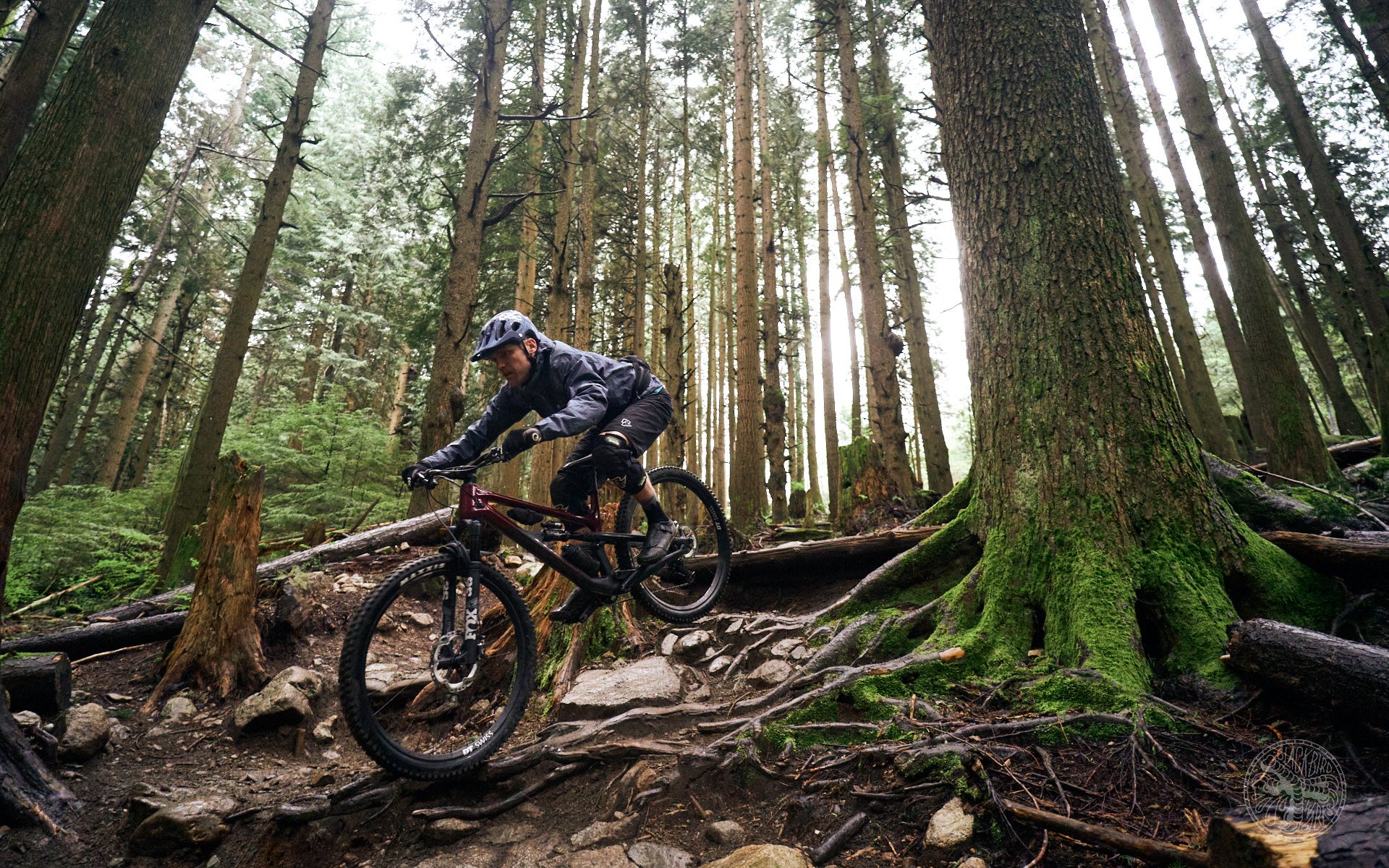
Trail Bike Review
2022 Canyon Spectral 125 CF 8 Review
“A small bike to get rowdy on.” That’s how Cam introduced the Canyon Spectral 125 in his first impressions review. This spirited little German offers 125 mm rear travel and a 140 mm Fox 36 up front, paired with an aggressive geometry more commonly found on longer travel enduro bikes. The first impressions article has all the details including specs and geometry numbers so I won't repeat those here.
Summarizing, Cam’s first riding impression was that the Spectral 125 certainly seemed capable of any trail he would throw at it but the shorter travel’s narrower margin for error initially had made him approach challenging trail sections a bit more cautiously than usual. The hypothesis was that more time on the bike would take away that mental barrier and let him ride the Spectral 125 without reservations.
Long story short, time was scarce for Cam and eventually it was me, after taking the Spectral 125 out for a few rides and finding myself intrigued by it, who was tasked with testing and reviewing the bike. One thing I can say for sure is that I was never able to test the limits of the bike, and I never expected to. The rider was the limiting factor in this case. However I think I’ve been able to get familiar enough with it to grasp what the Spectral 125 is about and how it wants to be ridden.
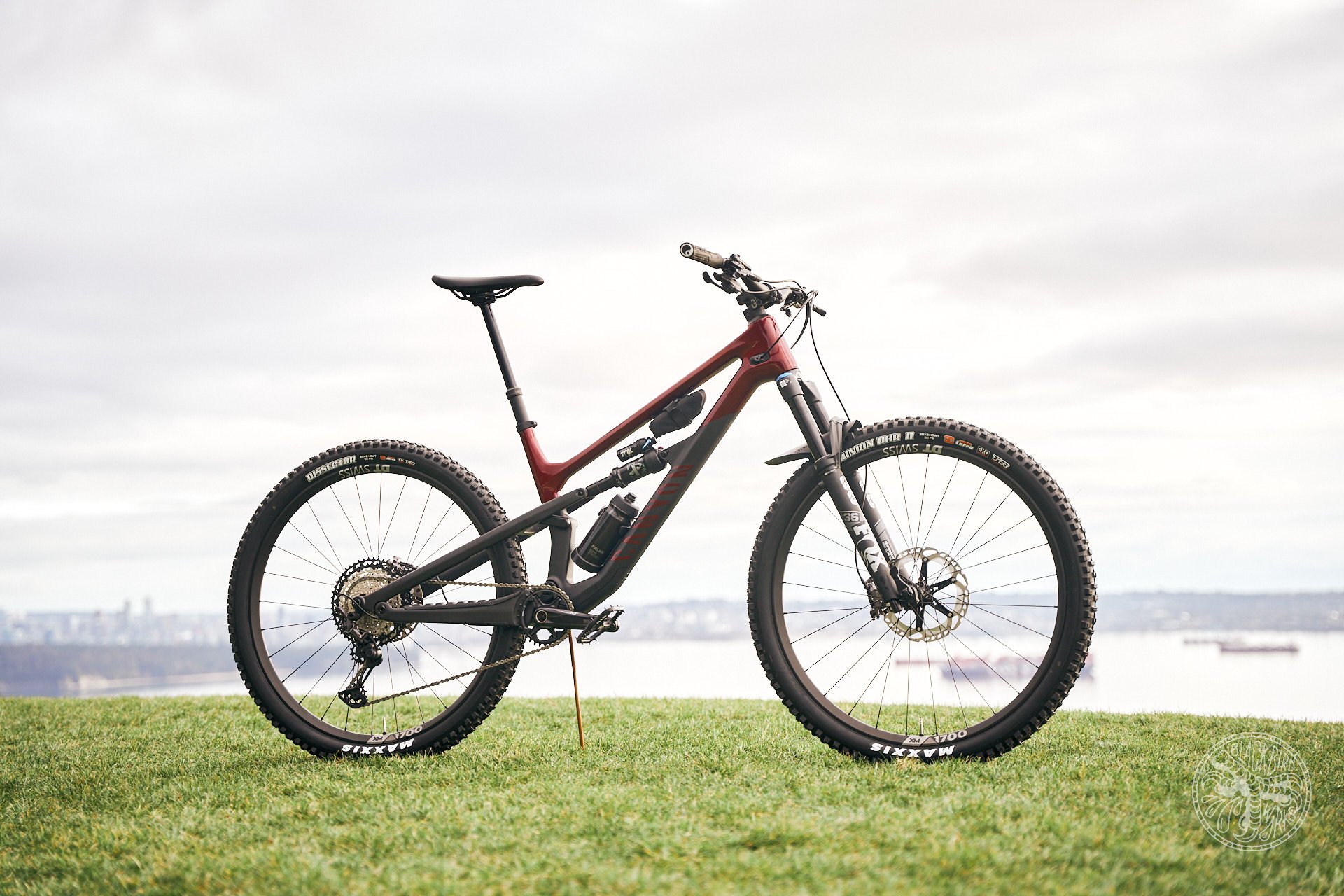
The Spectral 125 is a pretty bike - it received lots of positive comments on its looks during the test.
Setup
Canyon suggests 25% sag for the rear shock and after some experimentation with up to 30%, I eventually found myself in agreement with Canyon’s recommendation. Although at 125 mm it isn’t exactly plush, the rear suspension is very active. It does ramp up quite progressively and I typically didn’t use full travel except when I needed it to compensate for a botched move. That’s fine by me, intuitively it felt like I found the sweet spot for my riding.
Up front I settled on about 20% sag for the 140 mm Fox 36. I normally prefer to run my (longer travel) forks relatively soft with very light damping, relying on a fast rebound to keep it composed. On the Spectral I needed a bit more air and rebound damping to make up for the shorter travel and match the feeling of the rear end.
The geometry of the Spectral 125 is very close to what I’m familiar with on my personal bike (a 2020 Giant Reign 29) so in terms of fit and cockpit setup I was able to feel at home very quickly. At my height (6’ 2” / 187 cm) some would prefer the extra reach of an XL but for my body, which comes with some history resulting in reduced mobility around my hips and lower back, the L felt spot on.
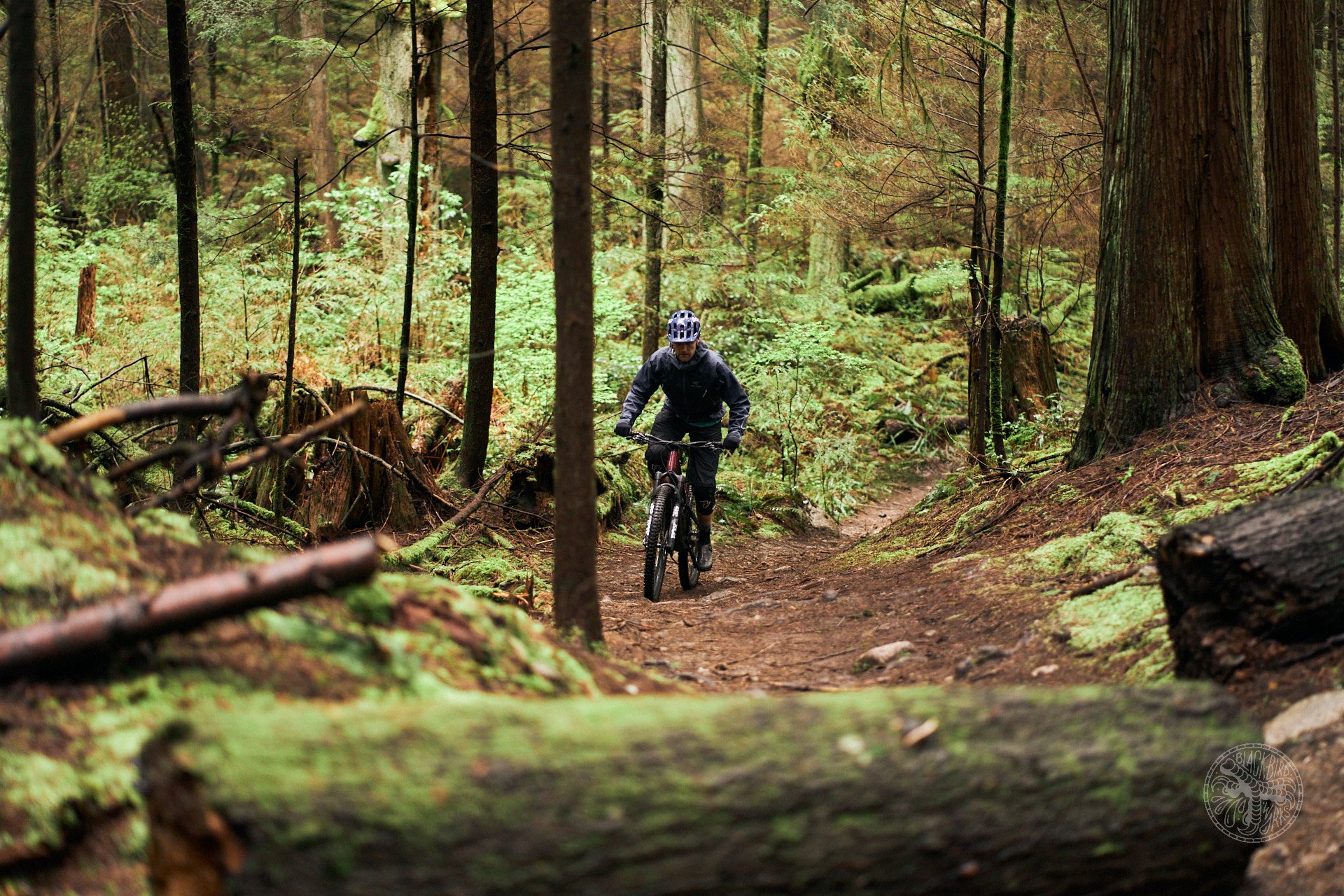
The Spectral 125 climbs just fine and provides plenty of traction....
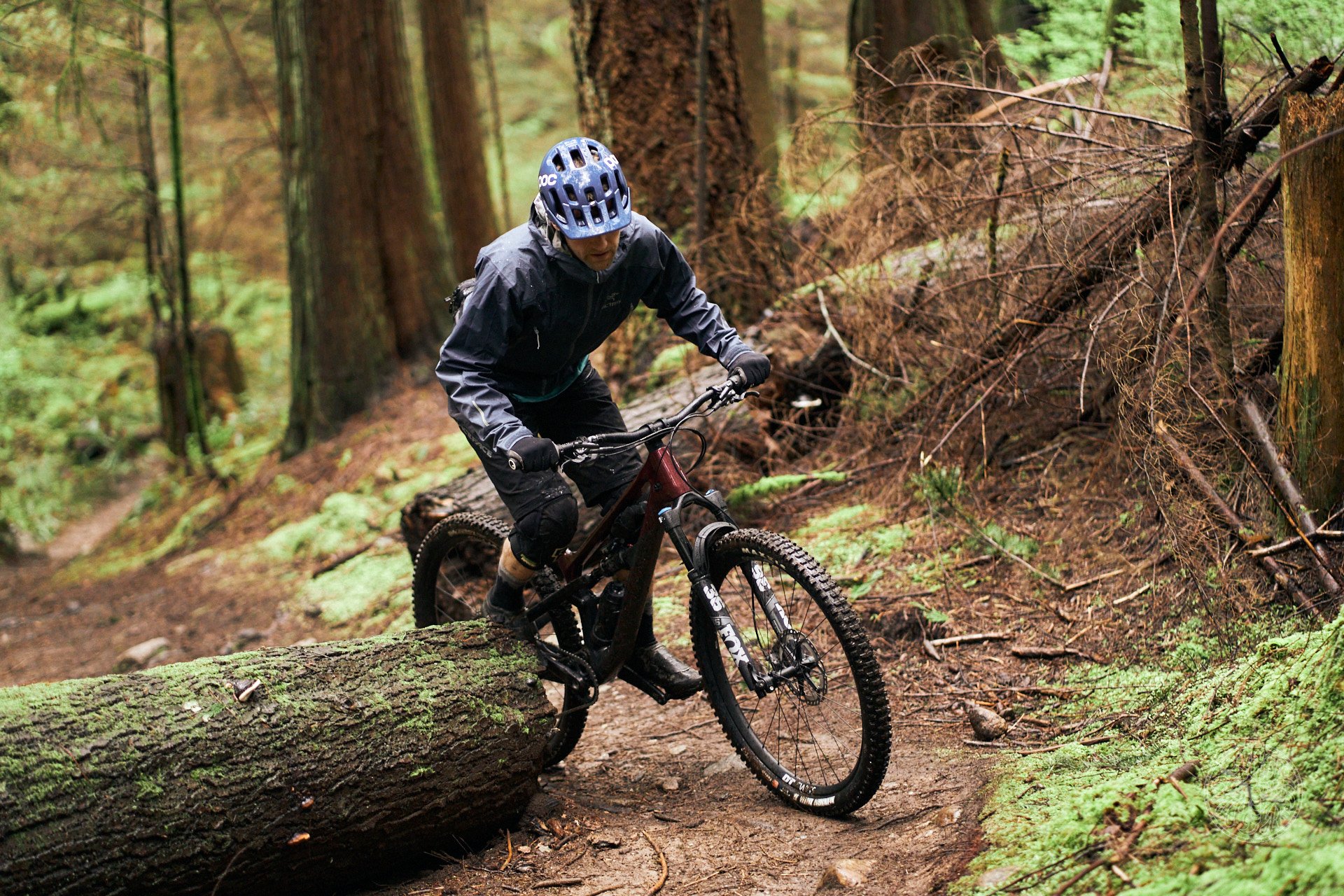
...but it lacks that energetic feeling that bikes with more anti-squat have when pedaling up.
Riding Impressions
Climbing
On the way up the Spectral felt slightly lacklustre for a 125 mm bike. Don’t get me wrong, the Spectral climbed just fine, especially in technical terrain where its active rear end provides plenty of traction. It just lacked that energetic feel that some other bikes have when pedaling uphill - in some cases bikes with significantly more rear travel. I fully admit that I'm far from an expert on suspension design but the consensus in the NSMB group chat seemed to be that my impression is consistent with most Horst link bikes (like the Spectral) typically being very active under pedaling while the dual link designs of the bikes that made up my frame of reference (like my personal Giant Reign 29) typically have more anti-squat.
I had no issues navigating steep uphill switchbacks on the Spectral 125 but some may find the slack geometry a bit unwieldy in those situations. I'm used to climbing on slack bikes so I don't know any better.
Bottom line, the Spectral 125 is not optimized for climbing but it got me up without too much trouble.
Cross Country
The Spectral 125 felt least at home on rolling and meandering XC-style trails where the slack geometry sometimes made the ride feel downright boring. Pedaling harder and attacking corners helped but it still wasn’t an XC bike. If you ride this type of terrain a lot you may have more fun on a bike with a more nervous geometry.
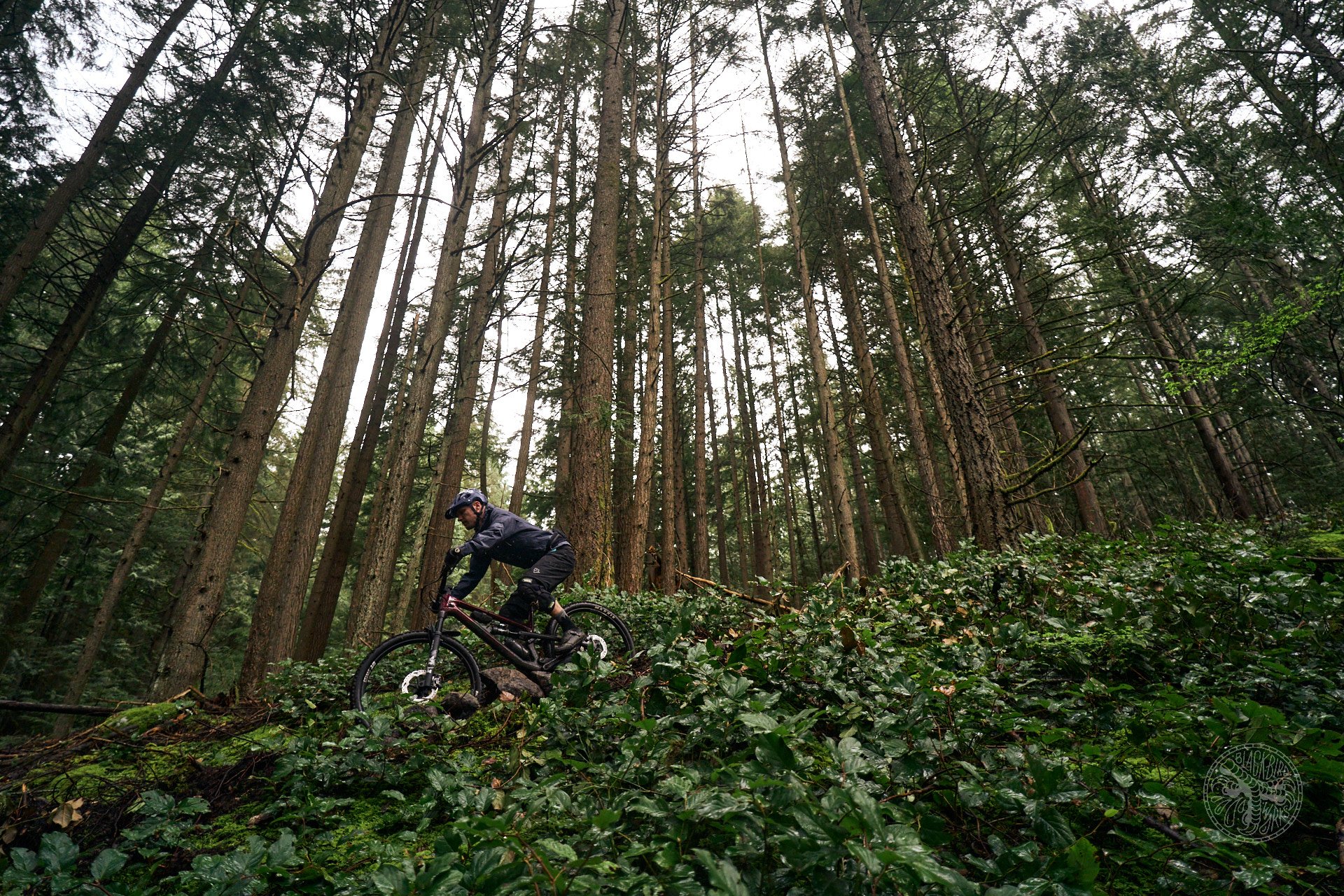
Rolling and meandering XC trails can feel a bit boring on the Spectral 125.
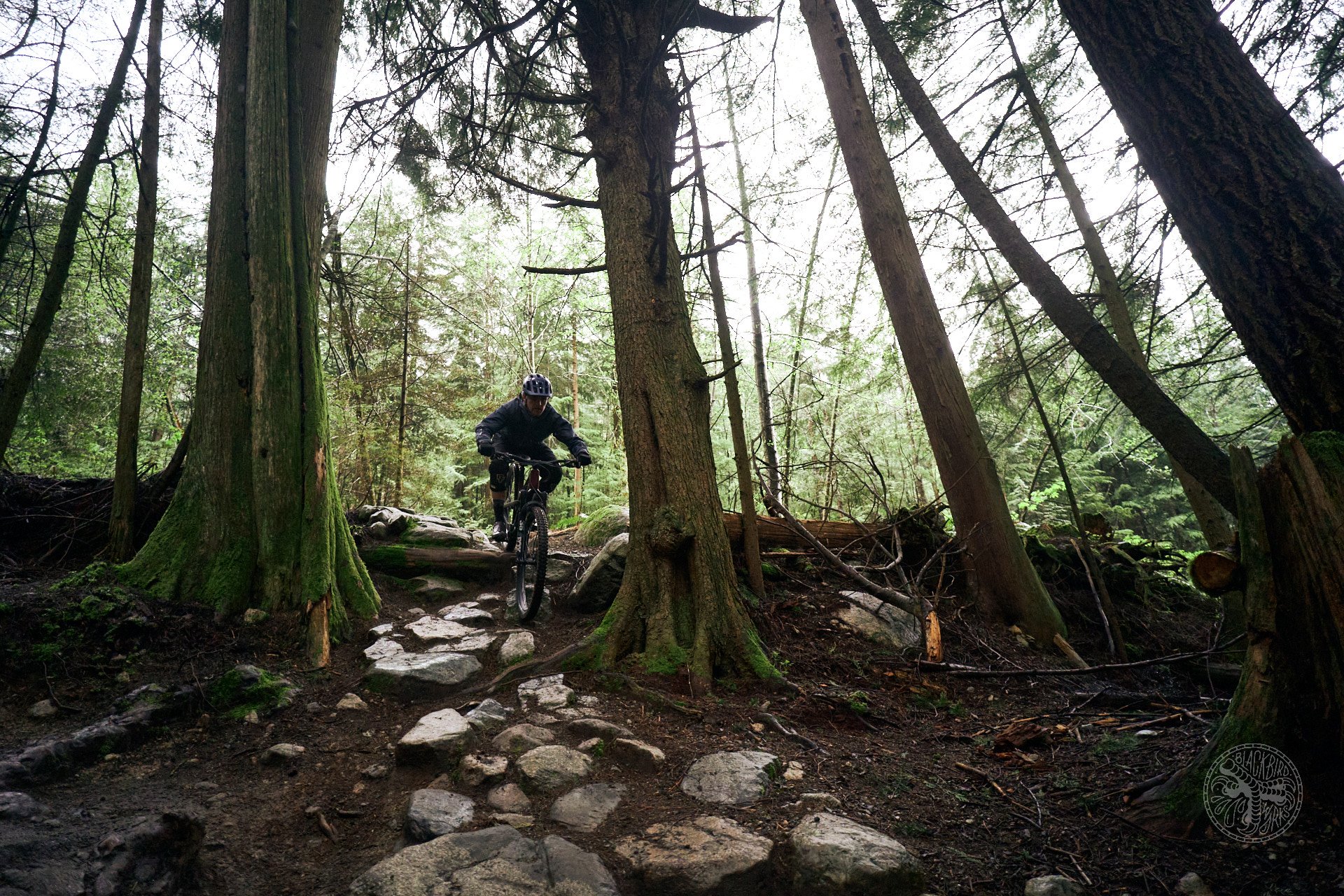
The Spectral brings out moderate tech in the trail rather than filtering it out.
Descending
Descending on fast, flowy, moderately technical trails the Spectral 125 really came to life. The bike is made for this type of terrain, the geometry encouraged me to let the brakes go and lean into corners aggressively. The sharp ramp-up of the short travel resulted in a nice amount of positive trail feedback and just begged to pump every indentation in the trail and look for opportunities to get some airtime. Every single trail in this category that I rode on the Spectral 125 resulted in an exhilarating descent.
Steep, slow tech, a trail style we have a lot on the Shore, was just fine on the Spectral 125. The geometry instilled confidence and with reasonably careful line choice I felt the bike generally had sufficient travel in this type of terrain. There was less margin for error when I screwed up but at the slower speeds this didn’t really make a significant difference.
On fast and rough trails things got more complicated. I found this the hardest type of trail on the Spectral 125 but also the most interesting. The geometry encouraged speed but the travel initially felt like it came up short when plowing through rough terrain. The Spectral 125 quickly exposed some carelessness that had crept into my riding after being on longer travel bikes for so long. I had to either slow down and be more careful in my line choice or be much more proactive and use more body English to work with the terrain and maintain speed and composure. As I got more accustomed to the Spectral 125, I started getting better at it and towards the end of the test I felt like I was getting real good at it. I had to work harder but, compared to a long travel enduro bike, this way the Spectral 125 really made me feel more one with the bike and the terrain on fast chunky trails.
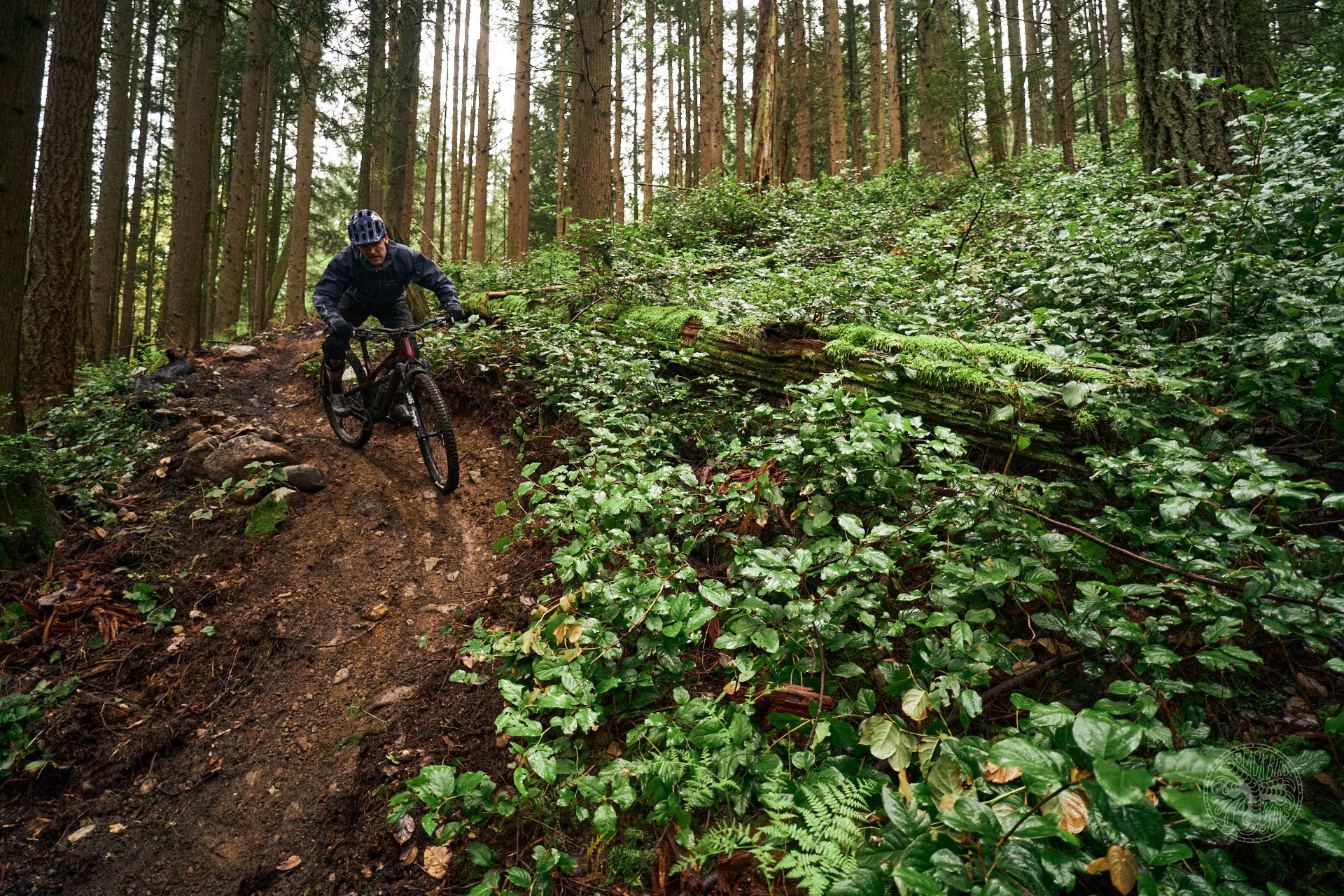
Fast singletrack. That's the terrain the Spectral 125 is made for.
Technical Report
The Spectral 125 felt solid the entire time I had it in my possession. The only minor issues I encountered were occasional creaking noises.
I tracked one creak down to the rear axle having loosened itself, a problem easily mitigated on the trail using the axle’s pull-out lever and, once back home, solved by a good clean and torque to spec.
A different creaking noise coming from somewhere around the bottom bracket and main pivot area was too minor and intermittent for me to be annoyed enough to track it down.
To be fair, the Spectral was served a menu of rough trails and a wetter-than-usual BC Spring with the associated overdose of post-ride hose downs. I feel like in such circumstances it’s not unreasonable to expect a rider to frequently check all bolts and axles are tight and if necessary treat the bike with a thorough cleaning and some fresh grease and treadlock in the right places. With the threaded bottom bracket and user-friendly looking pivot hardware, the latter shouldn’t be too much of a chore.
It’s great that Canyon was able to create space for a bottle mount in the frame but due to its low placement I found it a bit awkward to reach while riding and the bottle tended to get covered in dirt. The special fit 600 ml Canyon bottle was fine although I would have preferred to be able to fit any regular sized bottle.
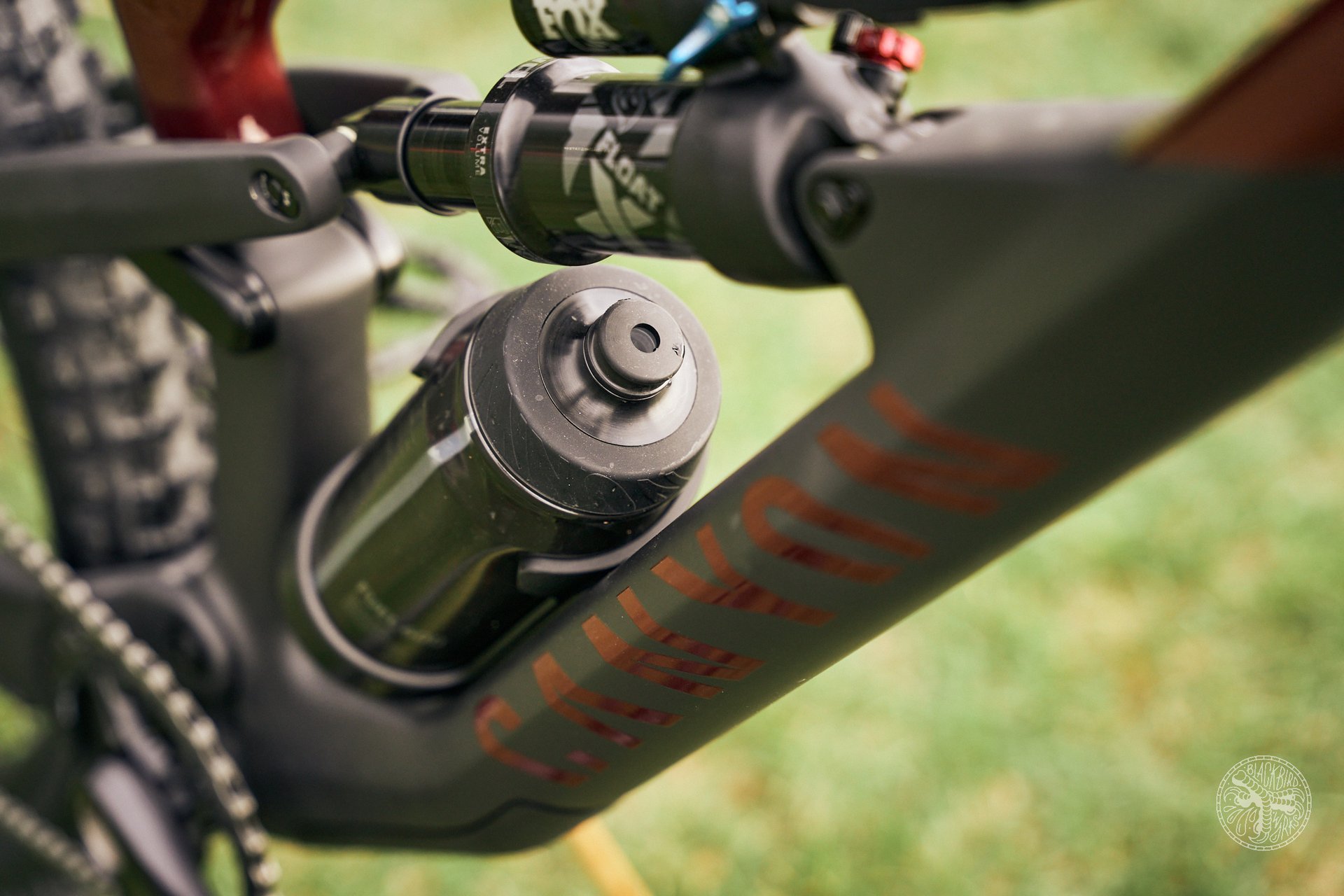
The bottle mount sits low in the frame and can be a bit awkward to reach.
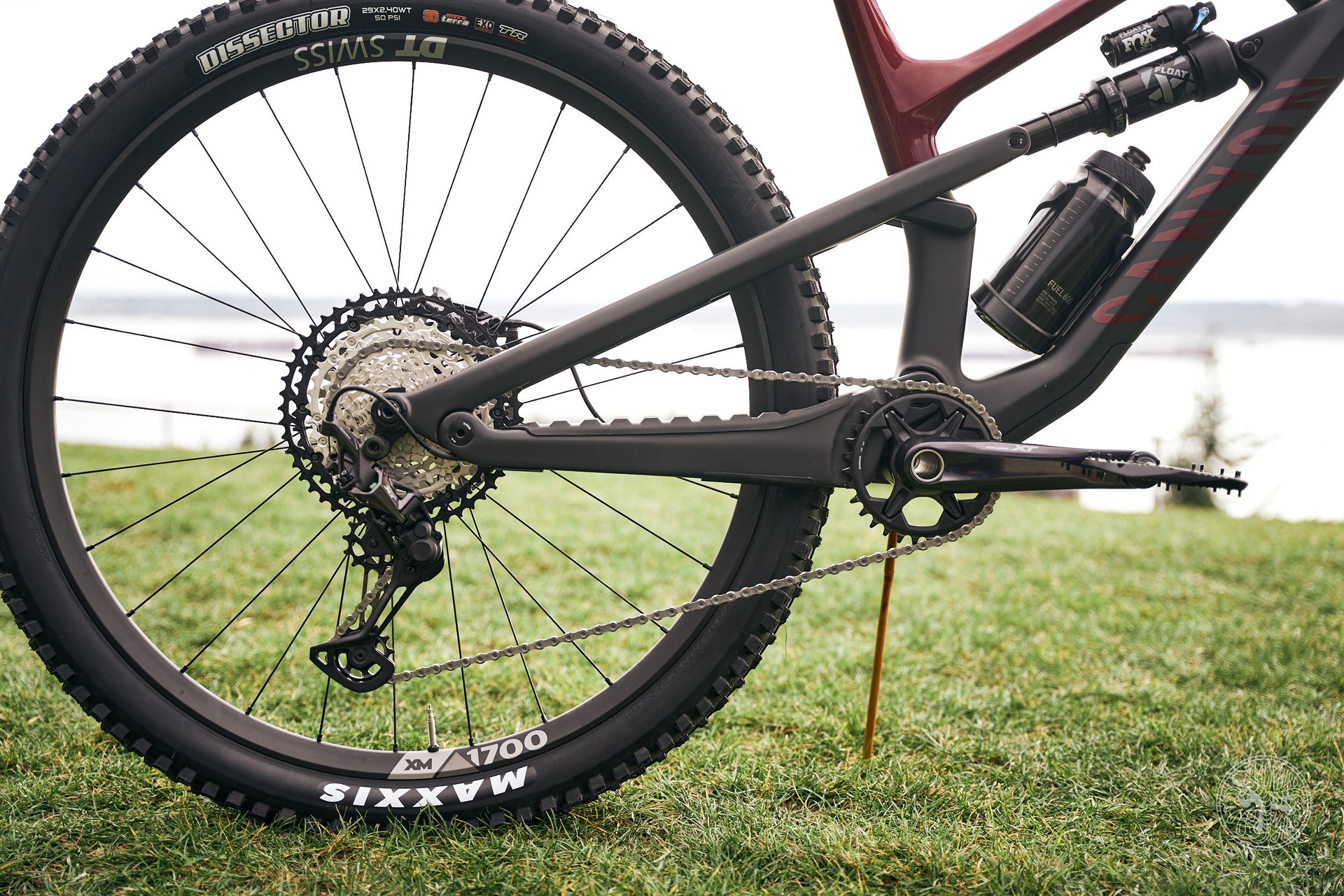
The XT drivetrain was a pleasant surprise with its sensible gear ratios.
Components
The Spectral's component spec worked perfectly fine for me and what little I would change is entirely location-dependent.
The full XT drivetrain was my first experience with Shimano 1x12 and I really liked the gear ratios of Shimano’s 10-51 cassette. With SRAM’s 10-50 I prefer a 30T chainring but Shimano’s shorter steps between the largest cogs meant the 32t chainring on the Spectral worked well for me.
The tire spec - a Maxxis DHR II 2.4 EXO MaxxTerra in front and Dissector 2.4 EXO MaxxTerra in the rear - worked surprisingly well for me despite the wet Spring conditions on the Shore. I’d still prefer the softer MaxxGrip compound in front. The EXO casings held up but I ran the rear tire with a bit more pressure just to be sure. More aggressive or heavier riders may want to upgrade to a sturdier casing or run inserts.
The Canyon-branded dropper post felt a bit crude compared to higher end options I’ve been spoiled with but it worked flawlessly for the entire duration of the test and the 200 mm drop was much appreciated.
The Fox fork and shock, the DT Swiss wheels, and the Shimano XT 4-piston brakes are all components I could have chosen myself and they did their jobs as expected without any issues.
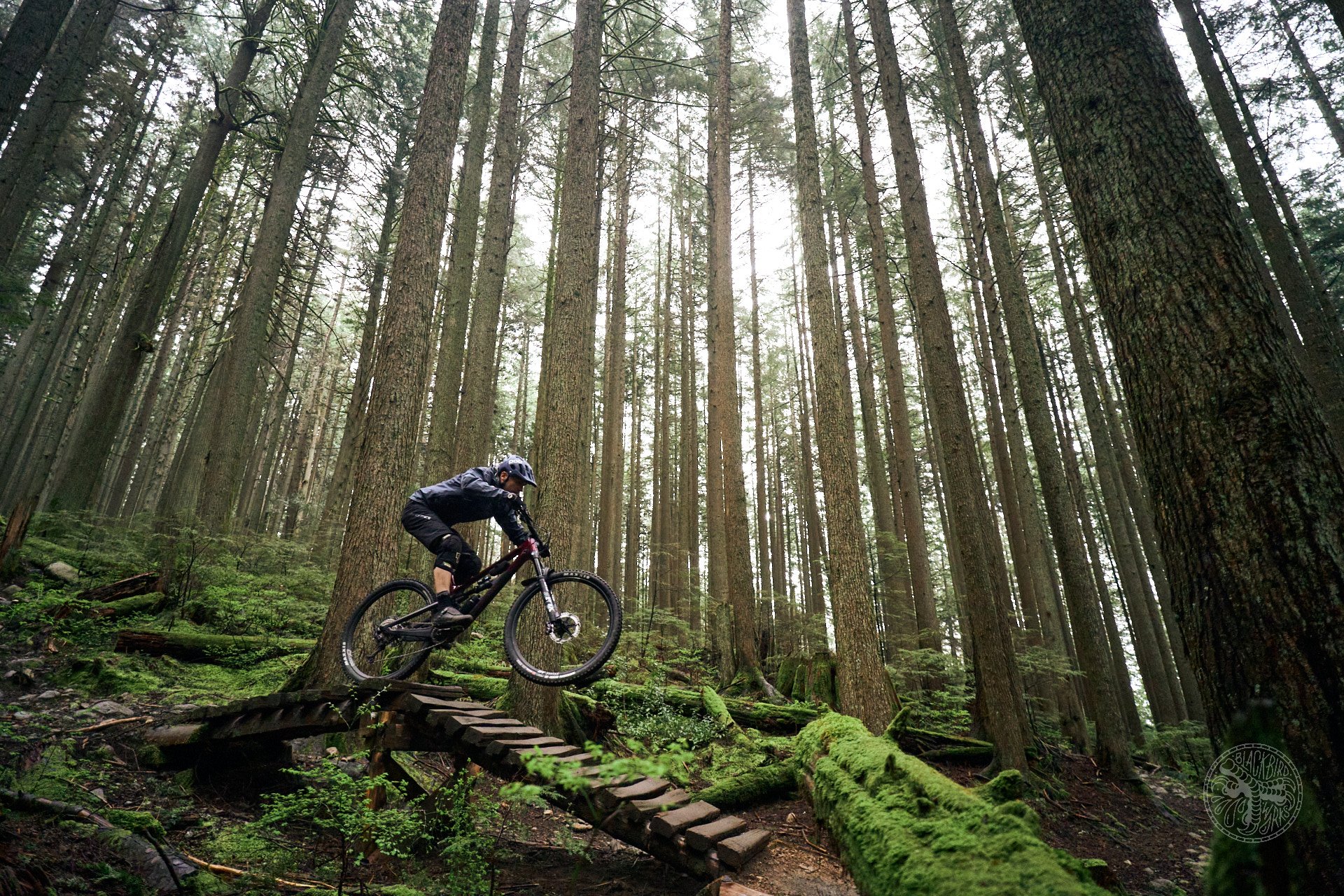
Although I'm not into big jumps the Spectral encouraged me to get some airtime on smaller features.
Final Words
I had a blast riding the Spectral 125. With its familiar geometry I felt comfortable on it right away but it took a good few rides to recalibrate myself to the shorter travel and sharpen up my riding. Once I figured out how to ride it, the small Canyon returned the favour by giving me a feeling of being more in tune with the trails I rode and being more rewarded for the effort I put in.
On the flipside, on those rides where I wasn’t able to bring my A-game, the Spectral 125 unapologetically told me to go fuck myself, resulting in being bounced around on the trail like an out-of-control beginner who is way out of their depth. This is not a bike I would want to ride all the time. Even on my best days riding the Spectral 125 and nailing the most challenging trails I took it on, fatigue did set in noticeably faster than I’m used to. For the riding I like to do on the Shore, I find around 20 mm more travel front and rear to be ideal, basically splitting the difference between the Spectral and a full on long travel enduro sled.
So who is this bike for? I can think of two types of riders who the Spectral 125 may be perfect for:
The first group would be those who predominantly ride fast, sufficiently steep but moderately technical trails who are looking for a bike that encourages an aggressive riding style while at the same time bringing out the moderate tech on the trail rather than filtering it out.
The second group would be strong expert riders who ride steep challenging terrain but tend to get a bit bored on their long travel enduro sleds. I imagine the Spectral 125 (perhaps as a second bike) could offer such riders a more engaging ride by challenging their skills and creating a more interactive connection with the trail without going all the way to a hardtail.
Even if you are not one of these types, I hope this review provides enough clues to help give you an idea whether the Spectral 125 may work for you. It is definitely an interesting mountain bike and one that I can recommend checking out to anyone looking for an aggressive short travel trail bike.
--
More information: https://www.canyon.com/en-ca/mountain-bikes/trail-bikes/spectral-125/
Location: Comox Valley, Vancouver Island, BC
Model Year: 1980
Height: 6'2" / 187 cm
Weight: 176 lbs / 80 kg
Riding style: Zenduro™
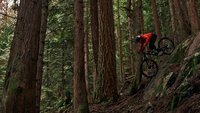
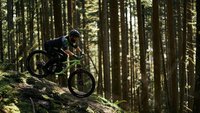
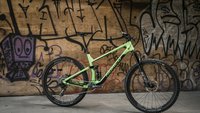
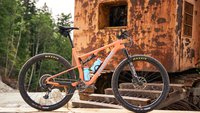







Comments
Tommaso Gomez
1 year, 10 months ago
In the spirit if super aggressive short travel rigs, I rebuilt my Spur with a 130mm Helm MKII Air and a DB Air IL in the rear (120mm), with an overdamped, highly progressive tune. On steep and rough trails around Pacifica, it's like being handcuffed to Jackie Chan. You can dance through wave after wave of violence and danger and laugh it off - as long as you bring your A-game. If you bring anything less than that, you will run out of talent and luck very quickly. I write this as I sit with my shoulder sling, wondering if the short-travel roulette game is still worth it.
Reply
Pete Roggeman
1 year, 10 months ago
Tommaso, you have a nice way with words.
Reply
Endur-Bro
1 year, 4 months ago
I'm currently attempting to figure out if a CC DB Coil IL will fit on this Spectral 125 CF frame?
> Bike Radar claims Sadly, there isn’t room on either the carbon or alloy bike for a coil shock,
Reply
kcy4130
1 year, 10 months ago
Is this guy new? If so, good job Niels. Bike seems pretty niche, sorta the opposite of well rounded.
Reply
Niels van Kampenhout
1 year, 10 months ago
Thanks! I'm not new but my main job is to keep the site running so I usually operate in the background. Occasionally I get tossed some gear to review and sometimes I take a test bike out for a ride. This was my first stab at reviewing a bike.
Yes the Spectral 125 is not necessarily an all-round bike but if it fits someone's riding style and trails it could easily be their only bike. There is nothing I wouldn't ride on it that I may otherwise ride on a different bike. Just a different experience.
Reply
kcy4130
1 year, 10 months ago
Yeah, I could see this bike being super fun on a certain trail type, super fast and smoothish (but not hardtail smooth). Master of one, rather than a jack of all trades, if you will. It'd be fun to try, cause it's somewhat an outlier.
Reply
Tehllama42
1 year, 10 months ago
Neils, thanks for the fantastic review.
As my personal rig sits incredibly closely to this one (150mm fork, 127mm rear travel effectively, Horst link), I keep reaching a lot of the same conclusions about what the bike excels with, and the tire selection dependency for something like this ends up being really tricky.
MaxxGrip out front becomes basically a requirement for using these bikes to their potential, because using the front center to its potential requires lots of grip, and it's not like these are particularly special when pedaling uphill or trying to hold pace in flat/level terrain, I actually run the DHR2 out front specifically to make up the braking traction that's otherwise lacking.
As far as how stiff to set things up, to me it was an area that required a bit more negative air chamber volume on the fork to really even things out - not only does the very linear fork and rather non-linear rear works quite well for me as long as the ramp-up is about the same on bigger hits, it lines up extremely well. Sitting on the compression circuits out back actually works surprisingly well for me, and having the back slightly overdamped actually accentuates what this bike excels at - going unreasonably fast on flowy/somewhat technical stuff where you can link thing together and take the odd big hit or send, then go right back to managing turn entry to carry the maximum speed in and out of turns of technical elements.
I'd also agree that this is one sometimes a valid 'only bike' candidate, and would be terrain dependent in that regard. In areas where lots of easy to access trails meet this definition of 'fairly technical, not too steep', then this is a brilliant ride. For trails that you can survive on a hardtail, this layout is an absolute weapon, and why the Fox36 was really the right choice.a
Reply
Niels van Kampenhout
1 year, 10 months ago
You're welcome and thanks for sharing your insights! I'm curious what bike that is?
I wondered quite a few times how the Spectral 125 would ride with 150 up front. I think 2 months of testing was enough to grasp the essence of the bike but it would have been nice to hold on to it for say 6+ months and really experiment with the suspension and tires and see how far the concept can be pushed.
Reply
Tehllama42
1 year, 10 months ago
This is a 2014 Rocky Mountain Instinct, with DVO shock and Pike RCT3 150mm out front (again, all cheap/secondhand parts). It needs the longer fork to end up in the same geometry area.
I think you got to the key part of it - no matter how well dialed in you get the suspension, you just get to bigger stuff and there just isn't enough travel to get you out of trouble the same way the point-and-bomb rigs with more travel can, but it's a bike that constantly taunts you into getting right up to that marginal limit and sending it anyway.
Out where I'm at, semislick rear and DHR2 front is a really good combination - up where you're at, I suspect eating the rolling penalty to run an Assegai out front and maybe keeping the dissector, or running an aggressor out back would probably work out quite well - as would running slightly wider/meatier tire carasses to really maximize rubber contact... but that's basically giving up any of the semi-XC capability the travel number teases, and just focusing it more towards that slice of trails this bike is perfect for bombing down at speed, and keeping it as a viable all-day whatever trail XC-trail setup that probably makes more sense for a larger market (which I'd argue that tire choice on stock setups is really intended to be a 80% of riders happy 80% of the time solution).
Reply
Justin White
1 year, 10 months ago
"...the bike generally had sufficient travel in this type of terrain. There was less margin for error when I screwed up but at the slower speeds this didn’t really make a significant difference."
"...I felt like I was getting real good at it. I had to work harder but [...] the Spectral 125 really made me feel more one with the bike and the terrain on fast chunky trails."
I like this, because I too find geometry makes way more difference in margin of error than travel does, at pretty much any speed besides Mach Stupid.
I've made both changes: more travel with matching geo, and also modernizing geo (longer front-center, longer effective reach, taller effective stack, slightly lower BB) while going down slightly on travel; and the geo made way more difference in my margin of error regarding keeping myself rubberside down and on the trail. More travel added margin of error for breaking things, mostly tires and wheels, when shit went rubberside up or getting tossed off the trail, but didn't do as much to enhance my ability to hang on when it got spicy.
Not that I want a 100mm/100mm bike with DH bike geo, but I'd rather have a modern-geo shortish-travel trail bike than a 5-year-old enduro bike, because it gives me more margin of error to keep things sorted, as opposed to giving the bike more protection against me letting things get out of sorts.
Reply
Glenn Bergevin
1 year, 10 months ago
The rare bike that climbs like it has longer travel than it does...
I think it'd be fun. Where I live there are no longer downs, not many big hits, so big bikes really go to waste, in my opinion, but there is plenty of opportunity to stay in sprint mode, pop off everything, and pretend you're a gnarly Enduro pro... I think a bike like this that encourages aggressive riding would suit that approach really well, without dragging around a couple inches of extra travel.
Reply
Niels van Kampenhout
1 year, 10 months ago
Sounds like you are a perfect candidate for the Spectral 125, Glenn! It's a super fun bike for what you describe.
About the climbing, I forgot to mention in the review that putting the shock in firm mode cleans up the climbing a lot. Of course that works best for longer climbs and you have to remember to switch it back to open.
Reply
4Runner1
1 year, 10 months ago
Once you free yourself from the climb switch, it’s hard to go back. I’ll never buy another bike that needs it.
Reply
Niels van Kampenhout
1 year, 10 months ago
Yeah I used it once on the Spectral and promptly forgot to switch it back before dropping into the descent...
Reply
Kenny
1 year, 10 months ago
Agreed, especially on a 125mm bike the concept of climb switch dependence is hard to reconcile.
Also agree on Niels doing a great job on this review. I was thinking the same thing - "where did they this guy come from? He's great!"
I didn't put it together with the [email protected] forum user name.
I like small bikes on the shore bit not ones that try to be big bikes.
My "main" bike is a revel Rascal 160f/130r. Not quite the plow of a bigger bike but it is amazingly responsive.
Reply
babyzhendo
1 year, 10 months ago
I'm on a Banshee Phantom V3 and this bike sounds quite similar, though maybe a little worse on the climbs...I think it's longer and slacker than the Banshee, so that's not totally surprising. As Niels mentions with the Canyon, it is a tiring bike to ride on rough trails, but when you nail a line on it its so incredibly satisfying. I probably wouldn't own it if I didn't already have a bigger enduro bike, but its an awesome complement. I'm on mine 3 days a week or so at Galbraith here in Bellingham, perfect venue for it.
Reply
Niels van Kampenhout
1 year, 10 months ago
It's been a while since I made it to Galbraith but I imagine that would be a great place to ride the Spectral 125 as well.
Reply
Justin White
1 year, 10 months ago
"Bottom line, the Spectral 125 is not optimized for climbing"
Not true. As you said yourself, it lacks a certain "feel", but that doesn't mean it's not actually good at going uphill, depending on conditions. Sure, something with a high[er] anti-squat is going to feel quicker on smooth trails, but that can come with a lack of traction when powering up rougher trails. Maintaining traction is a pretty important part of climbing, I'd go so far as to say something tuned slightly more towards being active and maintaining wheel contact with the ground is quite optimized for off-road climbing.
Reply
Tehllama42
1 year, 10 months ago
I'd say it just doesn't provide that 'rewarding' response when pedaling, especially out of the saddle uphill, and on smooth trails you can look down and see the shock just merrily moving around. For trails without any meaningful microterrain (basically winch and grinding up fire roads), it feels worse than it is in reality, but there is some wattage being dumped into heating up shock fluid that higher antisquat would 'help' with...
but the moment you're in technical climbing where traction up and over things is what actually matters, then these truly come into their own, and traction trumps anti-squat response (because wasting a couple pedal strokes to wheelspin counteracts multiple miles of energy bleed into the shock).
It really depends on the setup and layout of trail networks. Climbing actually enjoyable singletrack, I prefer the Horst link setup in this range, and I'll live with the comparative downsides (or having to drop on some compression via a climb switch to reduce bob)... but it's never a free lunch, just two divergent endpoints for an engineering compromise.
Reply
Niels van Kampenhout
1 year, 10 months ago
That's a fair point, Justin. The Spectral certainly didn't slow me down on the way up and indeed when we did a spontaneous climbing challenge on a challenging technical section I was the only of the group to clean it.
On the other hand, intuitively I feel like for example my Reign 29 with 145 mm rear travel doesn't have any less traction while still providing that encouraging/energetic feel of more anti-squat. I have no way of quantifying this but even if the perceived advantage is purely psychological I'd argue that a little extra free motivation makes for a nicer climbing experience.
In the end every suspension design is a trade-off and it's a matter of personal preference whether the designer's trade-off aligns with yours.
Thanks for adding some nuance with your comment!
Reply
Justin White
1 year, 10 months ago
Yeah, YMMV, horses for courses, all that, for sure. Always trade-offs, yup.
I guess I just don't care if the shock moves a bit going up a fire-road: maybe I just pedal real smooth and the shock typical doesn't move much on any bike for me; maybe because the climbs (and fast traverses) I really care about and take notice of will make the shock move a whole lot no matter what.
The psychological thing for me is being able to stay on the power and not have to think much about what the rear wheel is doing or about to do. Being able to trust it's going to follow the terrain freely and stay grabbed on whether I'm stomping squares through a field of baby heads or spinning circles up a ledge-y and punchy climb, that's my free motivation.
;-)
Reply
Tehllama42
1 year, 10 months ago
My thoughts exactly - one of those 'reviewers curse' type things where you ride something with >100% AS it feels like magic on certain trails, but you find yourself staring back confused at the rear tire when losing traction on a very familiar section of trail that is only slightly challenging or traction-sensitive. It's worse on shorter chainstay bikes I've found as well, but that might just be a sampling size error from stuff I've gotten to test ride.
It is very much as psychological as it is physics (or more so)... Pinkbike's climbing tests seem so show that as well - these are single digit percentage differences at most from best to worst on flat singletrack, and having traction limitations anywhere in between are going to close or reverse those gaps entirely
Reply
Pete Roggeman
1 year, 10 months ago
And then there are things like tires which help self-select a bike's attributes for the riding it was designed to do. If you put chunky 2.5s with sticky rubber on a short-travel bike (like this one) the performance gap narrows on everything, but particularly where you don't expect it as much (ie. climbing and pedal efficiency).
Reply
Hugo Williamson
1 year, 10 months ago
@ Neil’s Your 3 rd paragraph, is probably the best I have read for some time.
My view is not dissimilar, in that the best bike is the one that you feel confident on, irrespective of suspension design, brand or colour!!
Reply
Caspar Beronius Christensen
1 year, 10 months ago
so a modernday Process 111/ Smuggler… ?
Reply
Niels van Kampenhout
1 year, 10 months ago
Possibly! Unfortunately I never got to ride those bikes but I did ride the original Transition Scout at the time and I remember it having a similar character.
Reply
Joseph Crabtree
1 year, 10 months ago
Sounds a lot like the '19 Smuggler I had for awhile. Ended up getting a 160 f/145 r to save my body some abuse without that much downside.
Reply
Niels van Kampenhout
1 year, 10 months ago
I feel the same about my Reign which has 160 f / 145 r as well. It's a nice balance between getting enough feedback to not feel disconnected from the trail while still filtering the harshness out.
Reply
fartymarty
1 year, 10 months ago
Niels, great review - keep them coming.
I've had my Murmur at 160/140 and would happily rode anything on it. It's currently at 140/140 and is a little more responsive without being killing my upper body (like my rigid Krampus).
I do like this "aggressive trail" type bike - still enough for big lines but not as overkill as an enduro rig.
Reply
Hugo Williamson
1 year, 10 months ago
160/145 is a perfect combo for” big” trail riding in the UK, particularly if you live north of where you live FM !!
Reply
fartymarty
1 year, 10 months ago
There are a few local gems but they arent very long. 140/140 was fine at BPW.
Timer
1 year, 10 months ago
I'd guess it occupies a similar niche as the Norco Optic and the Banshee Phantom?
Reply
Zombo
1 year, 10 months ago
I put a -2 angleset on my 111 and can confirm that it rides pretty much like the bike described in this review.
Reply
Velocipedestrian
1 year, 10 months ago
Submit it for a Min-Max article?
Reply
Tehllama42
1 year, 10 months ago
I'm sure they're already being overran with dumb stuff like my submissions.
Reply
Zombo
1 year, 10 months ago
This comment has been removed.
JT
1 year, 10 months ago
As after Cam's review I find myself wishing this had come out prior to picking up my Trance X. This looks to check more of my personal boxes. Great write up, Niels!
Reply
Niels van Kampenhout
1 year, 10 months ago
Thanks, JT! The Trance X isn't too shabby either.
Reply
cheapondirt
1 year, 10 months ago
I might have posted this under the first look article but I would love to take this thing for a rip in Whistler's Creekside zone.
Reply
IslandLife
1 year, 10 months ago
I think a lot of riders bored with the excess of the 160, 170, 180 enduro/super enduro bikes are looking for a little more fun/connection with the trail and their bikes. Now that geometry and suspension are so well sorted, bikes like this offer some great fun.
Last year I was on a Knolly Chilcotin (160/170) and while that bike could just blast through anything... sometimes it felt like you could just close you eyes and ride, haha. I sometimes felt "bogged down" in all that travel. And all that travel really only seemed necessary in a very few, infrequent situations. (Especially with hindsight).
This year, I'm on a Knolly Fugitive 138. But I didn't want a shorter travel bike to hold me back from some of the double/triple black trails/lines I love to ride. So I upped the front travel to 160 (from 150), put proper tires on it with inserts (tannus), coil shock and slackened it a little more with a Wolftooth angleset. Now my neutral setting is proper slack and for the extra gnar days, I've got a super-slack setting (so fun!).
This bike is probably the most fun and rewarding bike I've had in years. Short travel with lots of progression allows you to wind the damping out and gives you very supple initial to mid stroke traction, while the progression has your back for the bigger hits. Riding within less relative sag gives a bike so much more liveliness, pop and fun... yet if set-up right, I've found I haven't been held back from riding anything I rode on my bigger bike. Like Neils said, these bikes force you to be more active and engaged in the ride... no more closing your eyes and pointing it. And I've been very surprised by how often I've realized that it wasn't the bigger travel of my previous bike that allowed me to ride certain lines or trails. It seems it really is more about geo and properly sorted suspension kinematics, performance and set-up.
I think the only place these bikes will fall a little short is at the big bike parks (Whistler). But for me, I visit so infrequently (once a year if I'm lucky?) that I'll just rent a proper DH for the park and use this bike for everything else. Which also has the side benefit of keeping park lap abuse away from my daily driver.
And turns out, Strava says I'm faster... even on my gnarliest trails. Think I might stick around this level of travel for a while. Only thing that has me thinking now is... what a mullet set-up would feel like at this travel? Even easier to dance around and pick the right lines? Hmmm.
Reply
Tehllama42
1 year, 10 months ago
For me, it's a case of 'how much fun can I have without being one "traction event" away from a hospital visit'... and the answer to that seems to sit right in the 6" front 5" (ish) travel area, with lots of tire and insert to tolerate some stupidity, but not so much travel and capability that to make the bike come alive I should be seriously considering chest/back protection.
Will your Fugitive handle a longshock-and-mullet type thing? Just run it out to even travel, add the shock length, but drop to a 650B rear wheel and end up with a similar BB positioning? I've done this and really liked the results on my wife's bike, having evenly matched travel is actually a pretty nice bonus (although the front end feels more capable overall, it makes the drops to flat basically perfect)
Reply
IslandLife
1 year, 10 months ago
Yes! As for mullets, I've converted a modern 27.5 bike with adjustable geo to a mullet with excellent results... but i haven't heard the same about turning 29" bikes in to mullets... but who knows.
As for the Fugitive, while it has adjustable geo, it's already on the longest stroke shock that fits it's eye to eye so you can't "long shock" it. But there may be something coming down the pipe that just might fit the bill.
Although in saying that, as someone who flips their bikes every year, my mullet was the hardest to sell... probably partly because it was a converted bike... so I might just stick with full 29 until a good option arises.
Reply
Tehllama42
1 year, 10 months ago
For me, turning 29ers into mullet setups basically 'only' works in cases where you can combine it with a longer I2I shock (and more travel), which happens to conveniently offset changes by running a smaller rear wheel.
I'm running 8 year old bikes at this point, so resale value is basically an afterthought (even though it's still a thought, and whoever buys these off me will end up with a great deal.)
Reply
IslandLife
1 year, 10 months ago
Ya, I guess that could work... but what does jamming a longer eye I2I shock into the linkage do to the kinematics/leverage curve/etc...?
Reply
Tehllama42
1 year, 10 months ago
All kinds of things that I'm sure I wouldn't really want to stress myself thinking about - point being that if you extrapolate the leverage curves, usually it ends up being more supple early stroke, a bit greedy on travel mid-stroke, then have even more rampup. It's not ideal, but neither was taking something kinematically designed for 2x and making it 1x in my case.
Short answer, it just extends you off the left side (mostly) of the leverage curve, and a little on the right side (just because of how the air spring ramp-up works). End result is that it's really not that crazy... but again, a caveat that I'm a 235lb idiot riding these things, so suspension performance is always at least a little off the reservation for me anyway
HollyBoni
1 year, 10 months ago
"Last year I was on a Knolly Chilcotin (160/170) and while that bike could just blast through anything... sometimes it felt like you could just close you eyes and ride, haha."
That sounds perfect to me! Maybe i'm weird, but for some reason I like being overbiked, and I like feeling the bike (aka suspension) doing all the work under me.
My favourite is when you're charging down something just chunky enough, the bike is absorbing everything, you're nice and comfy, and you're just hearing that nice "thunk" sound the tyres are making. So good!
I also find I kind of want the opposite of lively and poppy for some reason... I want something that tracks and hugs the ground.
Reply
Hermux
1 year, 10 months ago
Hey Niels, just curious about the shock - does it come with compression damping? Looks like there is no dial on the top?
Reply
Niels van Kampenhout
1 year, 10 months ago
Good question. The shock officially has no LSC adjustment dial but 'Mikelb01' pointed out in the comments on the first impressions article that it should be possible to take off the black cover and adjust the LSC setting, as suggested by the technical drawing on the Fox website. I wasn't able to remove the cover with my bare hands and the factory setting turned out to work well for me so I didn't investigate it any further.
Reply
HollyBoni
1 year, 10 months ago
There is a thread about this on MTBR. Apparently you also have to buy the LSC adjuster knob, but it works after that.
Reply
Endur-Bro
1 year, 4 months ago
I'm currently attempting to figure out if a CC DB Coil IL will fit on this Spectral 125 CF frame?
Bike Radar claims
> Sadly, there isn’t room on either the carbon or alloy bike for a coil shock
Reply
Please log in to leave a comment.